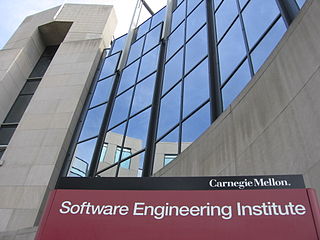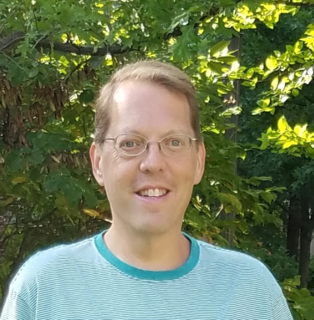Software engineering is the systematic application of engineering approaches to the development of software. Software engineering is a branch of computing science.

The Software Engineering Institute (SEI) is an American research and development center headquartered in Pittsburgh, Pennsylvania. Its activities cover cybersecurity, software assurance, software engineering and acquisition, and component capabilities critical to the Department of Defense.

Andrew James Viterbi is an American electrical engineer and businessman who co-founded Qualcomm Inc. and invented the Viterbi algorithm. He is currently Presidential Chair Professor of Electrical Engineering at the University of Southern California's Viterbi School of Engineering, which was named in his honor in 2004 in recognition of his $52 million gift.

The Hughes Aircraft Company was a major American aerospace and defense contractor founded in 1932 by Howard Hughes in Glendale, California as a division of Hughes Tool Company. The company was known for producing, among other products, the Hughes H-4 Hercules Spruce Goose aircraft, the atmospheric entry probe carried by the Galileo spacecraft, and the AIM-4 Falcon guided missile.

Paul William Richards is an American engineer and a former NASA Astronaut. He flew aboard one Space Shuttle mission in 2001.
Peter Pin-Shan Chen is a Taiwanese American computer scientist. He is a distinguished career scientist and faculty member at Carnegie Mellon University, who is known for the development of the entity-relationship model in 1976.
Simon Ramo was an American engineer, businessman, and author. He led development of microwave and missile technology and is sometimes known as the father of the intercontinental ballistic missile (ICBM). He also developed General Electric's electron microscope. He played prominent roles in the formation of two Fortune 500 companies, Ramo-Wooldridge and Bunker-Ramo.
Capability Maturity Model Integration (CMMI) is a process level improvement training and appraisal program. Administered by the CMMI Institute, a subsidiary of ISACA, it was developed at Carnegie Mellon University (CMU). It is required by many U.S. Government contracts, especially in software development. CMU claims CMMI can be used to guide process improvement across a project, division, or an entire organization. CMMI defines the following maturity levels for processes: Initial, Managed, Defined, Quantitatively Managed, and Optimizing. Version 2.0 was published in 2018. CMMI is registered in the U.S. Patent and Trademark Office by CMU.

David A. Bader is a Distinguished Professor and Director of the Institute for Data Science at the New Jersey Institute of Technology. Previously, he served as a Professor, Chair of the School of Computational Science and Engineering, and Executive Director of High-Performance Computing in the Georgia Tech College of Computing. In addition, Bader was selected as the director of the first Sony Toshiba IBM Center of Competence for the Cell Processor at the Georgia Institute of Technology. He is an IEEE Fellow, AAAS Fellow, SIAM Fellow. His main areas of research are in at the intersection of high-performance computing and real-world applications, including cybersecurity, massive-scale analytics, and computational genomics.
The Cockrell School of Engineering is one of the eighteen colleges within the University of Texas at Austin. It has more than 8,000 students enrolled in eleven undergraduate and thirteen graduate programs. The college is ranked fourth in the world according to the Academic Ranking of World Universities and eighth nationally by U.S. News & World Report, while all graduate programs are ranked in the top twenty nationally. Annual research expenditures are over $150 million and the school has the fourth-largest number of faculty in the National Academy of Engineering.
Faqir Chand Kohli popularly known as F. C. Kohli is an Indian industrialist. He is frequently referred to as the Father of the Indian Software Industry due to his significant contribution in Indian IT industry. He was the founder and first CEO of Tata Consultancy Services, India's largest software consultancy company. He has also worked as the deputy general manager of the Tata Power Company. He is Chairman of the Board of Governors of College of Engineering, Pune.
Harold A. Rosen was an American electrical engineer, known as "the father of the geostationary satellite", and "father of the communications satellite". He formed and led the team that designed and built the first geosynchronous communications satellite, Syncom, for Hughes Aircraft Company.

The IEEE Communications Society (ComSoc) promotes the advancement of science, technology and applications in communications and related disciplines. It fosters presentation and exchange of information among its members and the technical community throughout the world. The Society maintains a high standard of professionalism and technical competency. The IEEE Communications Society is a professional society of the IEEE.
IEEE Computer Society is a professional society of the Institute of Electrical and Electronics Engineers (IEEE). Its purpose and scope is "to advance the theory, practice, and application of computer and information processing science and technology" and the "professional standing of its members." The CS is the largest of 39 technical societies organized under the IEEE Technical Activities Board.
Chen Wen-tsuen is an ethnic Taiwanese computer scientist, a distinguished research fellow at the Academia Sinica and a lifelong national chair of the Ministry of Education, Taiwan. From 2006 to 2010, he was the president of the National Tsing Hua University, a premier research university in Taiwan.
The following outline is provided as an overview of and topical guide to computing:
Bill Curtis is a software engineer is best known for leading the development of the Capability Maturity Model and the People CMM in the Software Engineering Institute at Carnegie Mellon University, and for championing the spread of software process improvement and software measurement globally. In 2007 he was elected a Fellow of the Institute of Electrical and Electronics Engineers (IEEE) for his contributions to software process improvement and measurement.

Larry E. Druffel is an American engineer, Director Emeritus and Visiting Scientist at the Software Engineering Institute (SEI) at Carnegie Mellon University. He has published over 40 professional papers/reports and authored a textbook. He is best known for leadership in: (1) bringing engineering discipline and supporting technology to software design and development, and (2) addressing network and software security risks.






